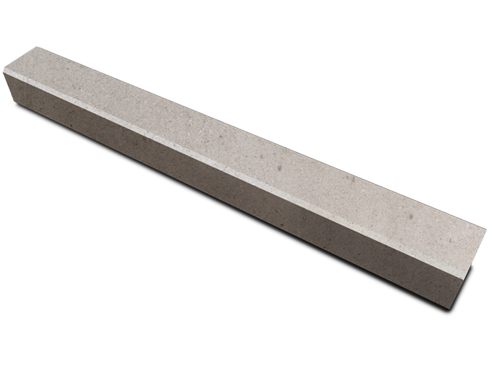Turnout sleepers: simple and flexible
For turnouts as well, concrete sleepers have become widely and successfully accepted. Their economic and technical advantages are the results of longer life cycles, less maintenance, and mechanized installation techniques. With their great weight, concrete turnout sleepers assure optimal position permanence and stability – even for turnouts that take traffic at high speed.
Technical data Turnout sleeper

| Permissible axle load | 25 metric tonnes |
| Maximum speed | 250 km/h |
| Concrete grades | C 50/60 |
| Concrete grades | 63,4 I/m |
| Weight (without rail fastenings) | 155 kg/m |
| Weight | 800-4700 mm |
| Width | 300 mm |
| Sleeper height | 220 mm |
| Height of rail-seat centre | 220 mm |
| High of sleeper centre | 220 mm |
| Supporting-surface area (total) | 3000 cm²/m |
| Standard application cases Schwerlastschwelle | Turnout sleeper |
Hinged turnout sleepers – a new solution for transport of turnout sleepers
Large-size, preassembled turnout components can range up to 4.8 m in length in the area of the turnout frogs and end sleepers. This means that they exceed the maximum length that is permitted, without exceeding normal loading sizes, for transport on conventional railway freight cars of Deutsche Bahn. In such cases, it is necessary to transport the turnout segments by costly special means of transport, so-called turnout transport cars. In close collaboration with the Track Materials Plant of DB Netz AG, in Witten, Germany, RAILONE GmbH has now developed a solution with subdivided and hinged turnout sleepers. This new technique enables assembly and quality-acceptance procedures for large-size turnout components in the production plant. The turnout set, including overlong sleepers with flexurally rigid coupling, passes through the same production process here as does a set with non-subdivided long sleepers. The pre-assembled large-size turnout components are then transported to the track construction site on conventional railway freight cars. To reduce the loading width of the frog section and of the end-sleeper set, the bolts of the coupling are partially unscrewed, and the short-sleeper components – including the assembled rails – are swung up and locked in place. At the destination, the components are swung back into their original, pre-transportation position on the rail transport car, and the bolt connections are assembled there. A railway construction crane or a road/rail excavator can be used to unfold the deployed components, and to unload and install the large turnout components into the turnout system.
The design of the hinged turnout sleepers has been tested in comprehensive laboratory tests. All fatigue tests have been successfully completed, and test results have been submitted to the responsible testing engineer and to the German Federal Railway Authority (EBA). The components have likewise successfully passed the tests stipulated by Deutsche Bahn for verification of fatigue limits for concrete sleepers by subjecting them to five million load cycles in accordance with the valid regulations contained in EN 13230. An additional requirement for tests of five million load cycles was furthermore successfully fulfilled, as well as fatigue specifications applying to the welded steel structure in accordance with best engineering practice. Final official approval is expected in the near future by the EBA.
After completion of the design and laboratory validation phase, the initial prototype was installed in summer of this year on tracks in actual operation by Deutsche Bahn. Installation was carried out during two periods of night possession in July of 2011. Laying of the components in the track bed took place without difficulty. In addition, the turnout ballast tamping machine was able to compact the ballast cleanly and without difficulty. Specifications for the required gauge and sleeper intervals were observed in accordance with quality requirements.
This innovation enables the transport of turnouts, completely pre-assembled in the production plant, on conventional railway freight cars: which appreciably reduces transport costs in comparison to delivery of conventional turnout versions with turnout transport cars. In addition, laying the pre-assembled segments – in contrast to conventional individual laying of the components – minimizes turnout installation times considerably. This solution likewise optimizes the availability of the turnout elements: since conventional railway freight cars are much more widely available on the market than are special turnout transport cars, disposition of turnouts with integrated hinged sleepers is possible faster and on a much more flexible basis.


